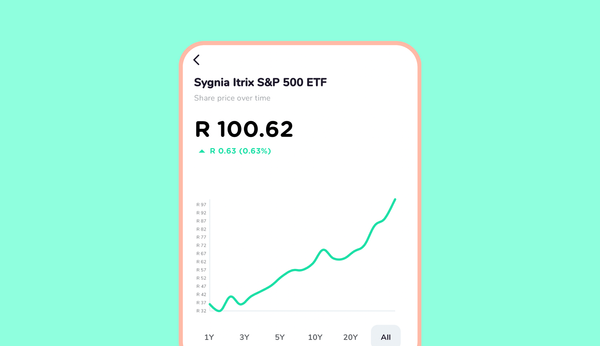Investment fees are your overall cost of investment. While the percentages often seem small, investment fees can have a big impact on your investment growth – their effect can add up over time. In this blog post, we unpack what the different investment fees are, what range you should expect based on the kind of investments you have, and how they affect your overall investment growth potential.
The 3 different types of investment fees you could pay
Understanding investment fees can be quite a complicated exercise, so I want to highlight the 3 main investment charges you will end up paying when you invest:
1. Fees on Assets Under Management (AUM)
The companies that manage the fund you are investing in need to make money themselves, so they charge an ongoing annual fee that is normally a percentage applied to the money you have invested with them. For example, if the fee is 1% a year, and you have R100 invested (and the investment, for whatever reason, stays at R100 the whole year), then you would pay the investment company R1 in annual AUM fees. These ongoing fees on assets under management apply to bundled investments like unit trusts, ETFs and tax-free savings accounts.
Most fund managers will charge a fixed fee (like the 1% per year mentioned above), but some managers charge performance fees. This means that if the investment performs better than the market or a predefined benchmark, they will start earning more than their base fee. This is meant to align their incentives with yours as an investor but it doesn't always achieve this.
Generally the lower the expected or historical return on the product, the lower the fee. For example, money market funds charge lower fees in comparison to managed equity funds. Passive investment funds – like index-tracking ETFs – generally charge low fees as the investment strategy of the fund tracks the performance of a predetermined ‘index’ or group of companies – there’s less ‘human work’ involved.
Now if you look at a fund fact sheet, you may see a number of different fees shown – this is where it can get confusing. The fee quoted by the fund manager is just what they charge, but investors often pay fees on top of that for other costs incurred. The different types of costs are calculated as follows:
- Total Expense Ratio (TER). This includes the fund manager’s fee as well as any direct total costs involved in managing the fund. These can include bank fees, custody fees, trustee fees, administration fees, or audit fees, to name a few.
- Transaction Costs (TC). These relate to costs incurred in buying and selling, and include brokerage fees, securities transfer tax, and any hedging costs.
- Total Investment Charge (TIC). This is the sum of the TER and TC above.
2. Fees Charged by the Investment Platform
Investment platforms ‘host’ the funds you invest in so that you can easily view the balance, track the progress and make transactions. These platforms may be run by the same company that manages the investment fund you are investing in (like Allan Gray), but not necessarily.
When opening an account with a specific platform, it is always essential to check if they charge platform fees and how much they are. For example, if you are investing R100 a month and there is a R10/month platform fee, a good portion of your savings will be wiped out. Even if you earn a decent return, you may still struggle to break even.
If you are investing through a linked investment service provider (LISP) – a specific kind of investment platform that allows you to invest in products managed by different fund managers on one platform – they will generally only charge you an ongoing percentage-based fee on the assets you hold, and not a fixed monthly fee.
Some investment platforms will also charge activity-based fees. This could be in the form of trading or brokerage fees which you pay when you trade shares or ETFs and are generally once off in nature – you pay these fees when you buy or sell.
3. Fees for Financial Advisors
If you engage a financial advisor, then you will also need to pay for their service. These fees can differ in style. Some advisors will charge you an ongoing fee that is based on the assets you hold, similar to the fees a fund manager or LISP would charge. These fees are generally around 0.25-1% per year, and it will be up to you to negotiate the lowest rate possible.
In addition to the ongoing fee, some advisors may charge you an initial, once-off fee based on every new investment you make. The maximum they can charge as an initial fee is 3%, but again, you should negotiate with the advisor to get this as low as possible (or even get them not to charge this at all).
Some financial advisors will just charge you for their time – so effectively a consultation fee. Many people prefer this as you know what you are in for and the advisor fees don't eat away at your annual returns – as you can see all these fees add up very quickly. You could be paying 2-3% a year in fees on the product, platform and advisor, which makes it that much harder for you to build your wealth.
The Effective Annual Cost (EAC) is the total of all the fees you would pay: so, the sum of the TIC, any fees charged by the platform, as well as any advisor fees. This is also normally shown as a percentage.
Why it Matters to Know Your Investment Fees
Let’s bring it to life with an example. There are two investors who invest R100,000 for 20 years:
- Investor A incurs an EAC of 1% a year
- Investor B incurs an EAC of 2% a year
Let's assume that the return they earn before fees is 10%. After 20 years, Investor A’s investment is worth just over R560,000. However, Investor B – who pays the higher EAC – has R466,000. That’s a difference of R94,000!
It's not guaranteed that if you invest in a product with low fees that you will outperform a product with higher fees – it will always depend on the performance of the underlying investment. But fees are the one thing that you can control as an investor, so you should try to ensure that the products you are investing in are of a high quality, but also carry low fees.
A Note on Franc’s Investment Fees
If you find investment fees unnecessarily confusing, you’re not alone. One of the things we try to get right at Franc is not only to make our fee structure low, but also simple to understand. That’s easier said than done!
At the moment we charge a 1% per year fee on assets under administration (this includes the management fee charged by the underlying fund manager), a R1 per month platform fee and transactional fees if you transfer your investment between funds, exceed your annual withdrawal limit or need quicker access to your withdrawn funds than our normal 2-5 days. For those who are investing in ETFs there is also sometimes a charge when you trade in or out of the investment, however we do our best to keep these as low as possible. Franc’s fee also includes access to our robo-advisor, which helps you choose how to invest depending on your own personal circumstances as well as all our easy-to-understand educational content.










